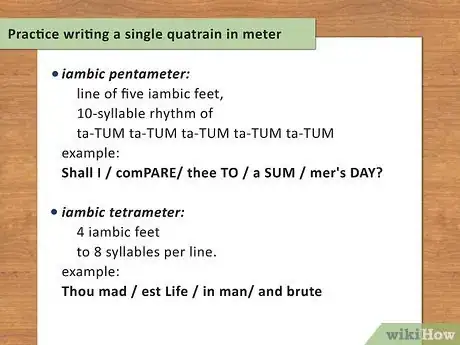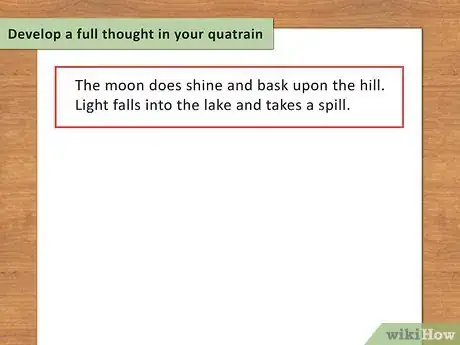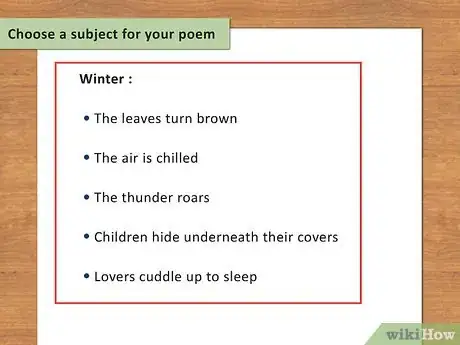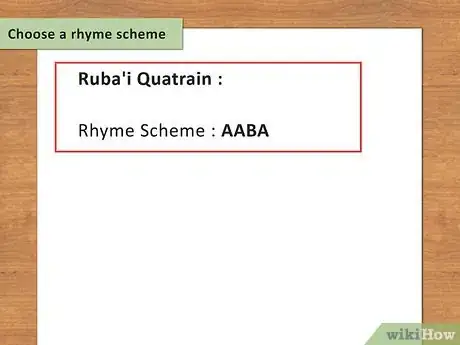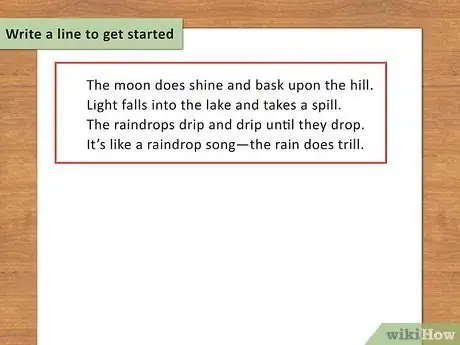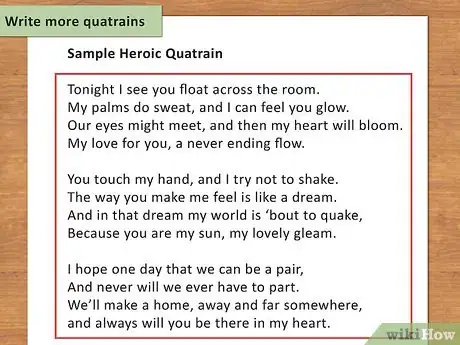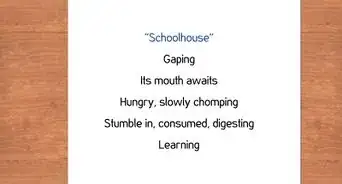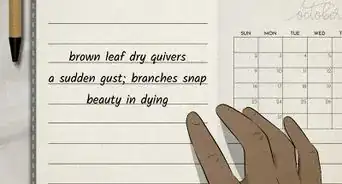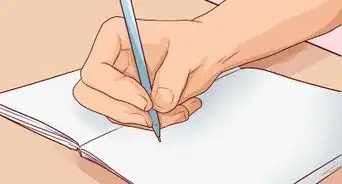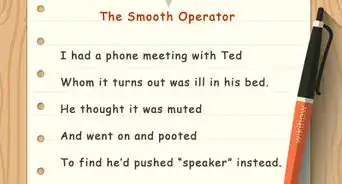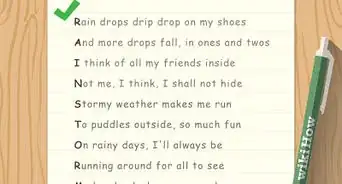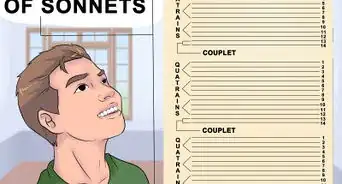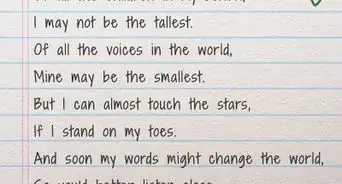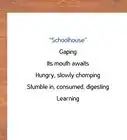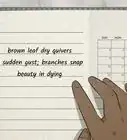wikiHow is a “wiki,” similar to Wikipedia, which means that many of our articles are co-written by multiple authors. To create this article, 101 people, some anonymous, worked to edit and improve it over time.
There are 14 references cited in this article, which can be found at the bottom of the page.
This article has been viewed 480,179 times.
Learn more...
Ever heard anyone sing Roses are Red? If so, you’ve already heard a quatrain poem. A quatrain is a stanza with four lines and a rhyme scheme. While a quatrain is only one verse, a quatrain poem can contain any number of quatrains (including one). As a bonus, the rhyme schemes can be extremely varied, making these poems particularly adaptable and accessible. These poems are flexible. Although, sometimes, it can be tricky. Choosing a subject, picking a rhyme scheme and finding words that rhyme are the steps to creating a one-of-a-kind quatrain poem.
Steps
Sample Quatrains
Exploring the Quatrain Form
-
1Practice writing a single quatrain in meter. A quatrain is just a stanza made of four lines with some kind of metrical and rhyme pattern. A metrical pattern means that each line has the same length and rhythmic stress pattern. For example, in an iambic pentameter poem, each line has five (pent) iambic feet (ta-TUM) that add up to ten syllables.[1]
-
2Experiment with rhyme schemes. Sometimes, while experimenting, you may even invent your own form. Rework your practice quatrain using different rhyme schemes. This exercise will help you figure out what sound you like best. Later, you can apply that rhyme scheme to the poem you want to write. There are no rules about the rhyme scheme of a quatrain poem, so you can run wild with it![4]
- Rhyme schemes are usually labeled with letters (ABCD). Every time a line of the poem ends in a new sound, assign a letter to that sound. So, if the last word of Line 1 is “smoke,” it becomes an “A” – and so does every other line that rhymes with “-oke” (“joke,” “baroque,” etc.). The next unique sound (and all its rhymes) would be “B,” the next would be a “C,” and so on. Some common quatrain rhyme schemes include:
- ABBA: We call this an "envelope quatrain" because the A rhyme envelopes the B rhyme. The result is a dense rhyme in the middle with a comforting envelope rhyme around it.
- When you write an envelope quatrain in iambic pentameter, we call it an Italian quatrain.
- When you write an envelope quatrain in iambic tetrameter, we call it an In Memoriam stanza. The name comes from Tennyson’s poem “In Memoriam A.H.H.”[5]
- ABAB: We call this scheme an alternate or interlaced quatrain because of how the rhyme sounds alternate.
- AABB: The double couplet has two very strong rhymes. If you use this kind of scheme throughout a long poem, the rhyme might start sounding too sing-songy. Be careful!
- You can also insert a third sound into the quatrain, even if it remains unrhymed: ABCB, ABCA, ABAC, etc.
Advertisement -
3Develop a full thought in your quatrain. A quatrain poem has two or more quatrain stanzas. Each stanza should serve as its own little thought bubble, like paragraphs in a story or essay.[6]
- Practice developing a single quatrain before sitting down to write a whole poem.
- Don’t worry about writing something that will develop into a full poem; this is just practice.
- Try to develop a full thought in four lines of metered writing.
-
4Read and study poems written in quatrains. Some rhyme schemes have a long tradition that you should research, but you don't have to follow any "rules." Learn the history of the pattern, but feel free to make it your own.
- Tennyson said that his grief took the form of the In Memoriam stanza after his friend Arthur Hallam died. That's why "In Memoriam A.H.H." has that metrical pattern. The tetrameter (4 feet) feels like unfinished pentameter (5 feet). The A sound comes early, then returns at the end of each stanza. This resembles the poem and poet's inability to move past Arthur's death.[7]
- Thomas Gray’s wrote “Elegy Written in a Country Churchyard” in Sicilian quatrains.[8]
- A.E. Housman used double couplets in his “To an Athlete Dying Young” to mimic the upbeat tone of a cheering crowd. This contrasts the death that closes the poem.[9]
- An example of a repeating ABCD rhyme scheme (where none of the first four lines rhyme with one another but instead rhyme with the lines of the next quatrain) can be found in the first two quatrains of John Allan Wyeth’s Souilly: Hospital:
Fever, and crowds---and light that cuts your eyes--A
Men waiting in a long slow-shuffling lineB
with silent private faces, white and bleak.C
Long rows of lumpy stretchers on the floor.D
My helmet drops---a head jerks up and criesA
wide-eyed and settles in a quivering whine.B
The air is rank with touching human reek.C
A troop of Germans clatters through the door.D
Writing a Quatrain Poem
-
1Choose a subject for your poem. What’s been on your mind recently? What problems have been bothering you, or what have you been happy about? Are you in love, or are you stressed about having too much work? Did you just get a new dog, or did your dog just die?
- By choosing a subject you’ve been thinking about a lot, you ensure that you’ll have a lot of material to write about.
- It may be that you can't think of anything specific that’s been on your mind lately. If that's the case, start with a generic topic like nature or emotion, and try to develop a more specific thought about it.
- Observation is also a great way to come up with poem topics. Go to a crowded place, like the mall or a train station, and crowd-watch. Try to imagine the inner lives of the people you see, where they’re coming from and where they’re going. Take notes to help you remember what you found interesting about them later. You can turn them into a character in your narrative poem or dramatic monologue.
-
2Choose a rhyme scheme. You experimented with different rhyme schemes with the practice quatrain you wrote. Choose a rhyme scheme that seems to fit the subject matter of the poem you want to write, or which you liked the sound of. For example, if you are writing a poem about grief or loss, use just the In Memoriam stanza's envelope rhyme. You don't have to use its iambic tetrameter.[10]
- Now that you’re working with more than one quatrain, you can think about chain rhymes. This is when a rhyme sound from one stanza gets drawn down into the next one: ABBA BCCB CDDC, and so on.
- Look at Robert Frost’s “Acquainted with the Night” for an example of a chain rhyme. Note that Frost used tercets (three-line stanzas), not quatrains, in this poem.[11]
- Make your rhyme scheme more interesting by mixing rhyme styles. A poem that reads AABA BBCB CCDC would be more challenging and interesting to the reader. Even if the first B and C seem lonely all by themselves, they get repeated a lot in later stanzas. The only D breaks up the pattern, and, is a nice reminder that you don’t have to make every line rhyme. To start your first poem, AABB would be the easiest.
-
3Write a line to get started. This first line is the base of your poem because it doesn’t have to rhyme with anything yet. Of course, it can sometimes be hard to start the poem right at the beginning. If you have a line in your head that you like the sound of – even if it doesn’t make any sense yet – write it down so that you can start writing around it.[12]
-
4Write lines around your original line to flesh out your quatrain. Keep the rhyme scheme in mind and think ahead to words that you want these lines to end on. Remember, a quatrain should be like a thought bubble or a paragraph. Develop a full thought within these four lines.[13]
- Use a rhyming dictionary or thesaurus for help if you get stuck on rhymes or synonyms.[14] [15]
- Brainstorm a list of words that rhyme with the last word of the line you've written, but try to find ones that relate to your topic.
- Build on the words you've brainstormed so they become a full quatrain. For beginners, try to create lines of similar lengths.
- Feel free to use slant rhyme, also known as off rhyme, to make a difficult rhyme work. Slant rhyme is when two words don’t rhyme completely but are like enough to feel like rhyme.
- Emily Dickinson was a great master of slant rhyme. In “Because I could not stop for Death —” she rhymes away with civility, chill with tulle, and day with eternity.[16]
-
5Read your quatrain aloud to check that it flows. It should feel natural when read aloud, as though the rhythm and rhymes click into place like a song. If it sounds bumpy, you need to revise. Shorten long lines and lengthen short lines so that the rhymes occur at satisfying intervals.
-
6Write more quatrains. Consider what you just wrote, then decide where that stanza leads to next. Remember that each quatrain should stand alone as it develops its own idea. It should also connect to the stanzas that come both before and after it.
- Add depth to the poem by including a turn. A turn is a line starting with a word like “but” or “however” that takes on a different tone from the rest of the poem. It often introduces a new element (ex. a dilemma, a question, a solution, or anything else the reader hasn’t anticipated up until this point).
Community Q&A
-
QuestionHow to do I identify rhyme schemes?
 Community AnswerRead the end of the lines well, and mark or circle the words.
Community AnswerRead the end of the lines well, and mark or circle the words. -
QuestionHow do I start a quatrain poem?
 Community AnswerBegin with an introduction. After considering the iambic pentameter, you should introduce the subject to the readers. If you are writing a long poem, you should introduce the topic at first. You might want to jump right into the action if you want to have a quatrain poem of just 2 stanzas.
Community AnswerBegin with an introduction. After considering the iambic pentameter, you should introduce the subject to the readers. If you are writing a long poem, you should introduce the topic at first. You might want to jump right into the action if you want to have a quatrain poem of just 2 stanzas.
References
- ↑ https://examples.yourdictionary.com/famous-quatrain-examples-in-poetry.html
- ↑ http://www.poets.org/poetsorg/poem/shall-i-compare-thee-summers-day-sonnet-18
- ↑ http://www.online-literature.com/donne/718/
- ↑ https://penandthepad.com/write-quatrain-poem-4516606.html
- ↑ http://www.britannica.com/EBchecked/topic/284377/In-Memoriam-stanza
- ↑ https://literarydevices.net/quatrain/
- ↑ http://www.online-literature.com/tennyson/718/
- ↑ https://www.poetryfoundation.org/poems/44299/elegy-written-in-a-country-churchyard
- ↑ https://www.poetryfoundation.org/poems/46452/to-an-athlete-dying-young
- ↑ https://examples.yourdictionary.com/famous-quatrain-examples-in-poetry.html
- ↑ https://www.poetryfoundation.org/poems/47548/acquainted-with-the-night
- ↑ https://penandthepad.com/write-quatrain-poem-4516606.html
- ↑ https://literarydevices.net/quatrain/
- ↑ http://www.rhymezone.com/
- ↑ http://www.thesaurus.com/
- ↑ https://www.poetryfoundation.org/poems/47652/because-i-could-not-stop-for-death-479



